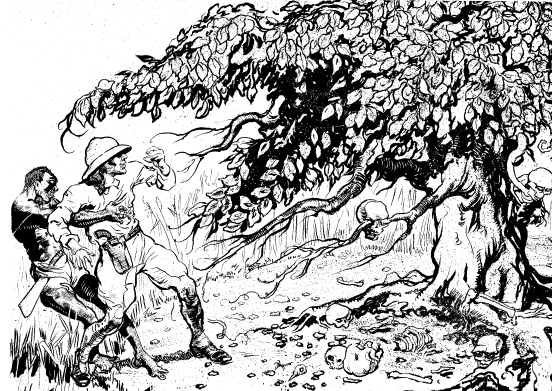
Exploring a tabooed piece of land on Mindanao, Mississippian planter W.C. Bryant discovered a 35-foot tree surrounded by bones and the smell of carrion. He was entering the circle to examine a skull when his guide suddenly pinioned his arms and pulled him backward “with the strength of a maniac.” Bryant followed the man’s gaze and saw that “the tree was reaching for him”:
The whole thing had changed shape and was horribly alive and alert. The dull, heavy leaves had sprung from their compact formation and were coming at him from all directions, advancing on the ends of long vine-like stems which stretched across like the necks of innumerable geese and, now that the old man had stopped his screaming, the air was full of hissing sounds.
The leaves did not move straight at their target, but with a graceful, side-to-side sway, like a cobra about to strike. From the far side, the distant leaves were peeping and swaying on their journey around the trunk and even the tree top was bending down to join in the attack. The bending of the trunk was spasmodic and accompanied by sharp cracks.
The effect of this advancing and swaying mass of green objects was hypnotic, like the charm movements of a snake. Bryant could not move, though the nearest leaf was within an inch of his face. He could see that it was armed with sharp spines on which a liquid was forming. He saw the heavy leaf curve like a green-mittened hand, and as it brushed his eyebrows in passing he got the smell of it — the same animal smell that hung in the surrounding air. Another instant and the thing would have had his eyes in its sticky, prickly grasp, but either his weakness or the brown man’s strength threw them both on their backs.
The charm was broken. They crawled out of the circle of death and lay panting in the grass while the malignant plant, cracking and hissing, yearned and stretched and thrashed to get at them.
That’s from “Escaped From the Embrace of the Man-Eating Tree,” in the American Weekly, Jan. 4, 1925. Interestingly, naturalist Williard Clute tracked down the author and published a followup in American Botanist that April:
“The author of this tale, having been questioned, replies under date of January 8, 1925, that ‘the tree is there and in the main the account is true. The circle at the foot of the tree was about 80 maybe 100 feet in diameter. The tree looked nothing like the drawings [in the paper]. It was round as a smoke stack — the trunk, I mean, and dark gray or ash-color. The whole tree was symmetrical and the tree and ground under it, was very inviting to a storm-beset or sun-depressed traveller. The clucking and hissing was, I judged, from a gluey consistency of, or on, the leaves. My impression was that if it reached me, it would fasten and hold me, thus it had done to apes, birds, and animals.'” Stay out of the Philippines, I guess.
